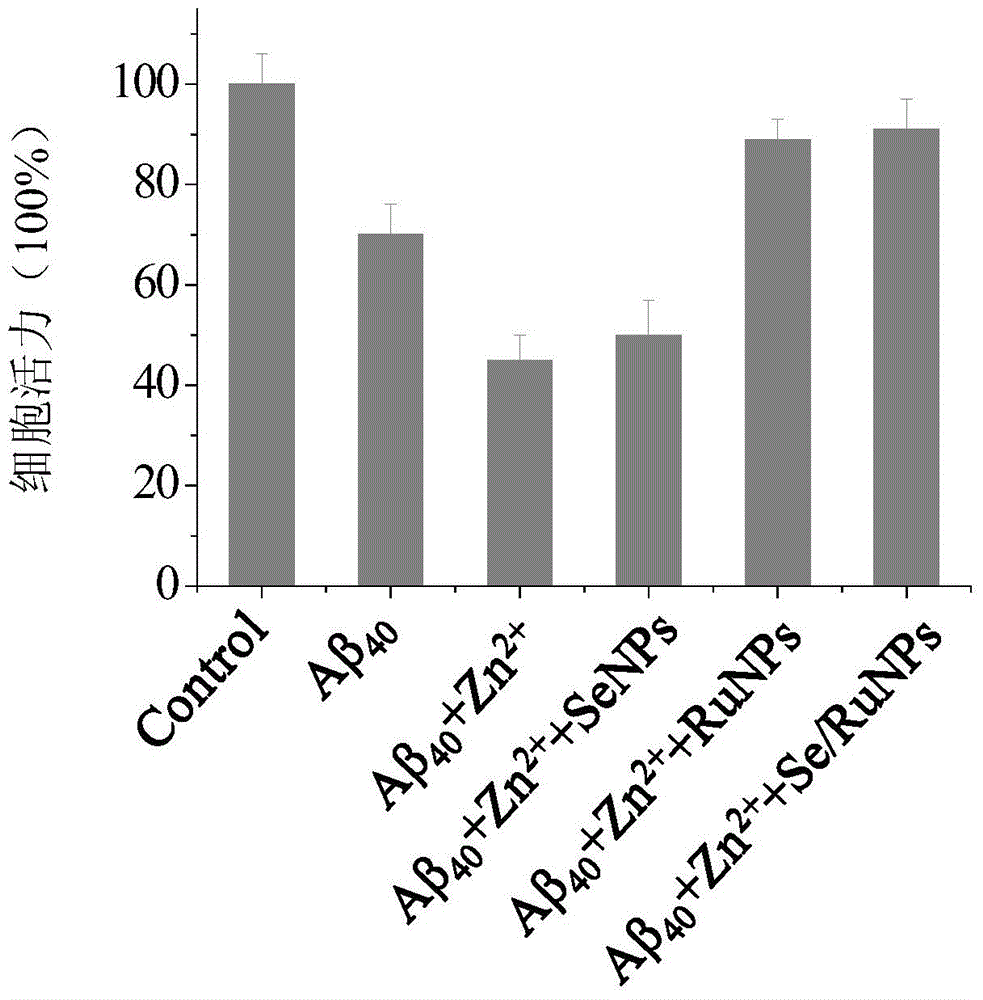Nano-particle for inhibiting aggregation of alpha-beta and metal ions induced alpha-beta, as well as preparation and application
A technology of nanoparticles and metal ions, which is applied in the direction of active ingredients of heavy metals, medical preparations of non-active ingredients, active ingredients of sulfur/selenium/tellurium, etc., can solve the problems of non-selectivity, toxic and side effects of chelation, and achieve improved Biocompatibility, simple method, and the effect of inhibiting Aβ polypeptide aggregation
- Summary
- Abstract
- Description
- Claims
- Application Information
AI Technical Summary
Problems solved by technology
Method used
Image
Examples
Embodiment 1
[0038] Embodiment 1: the preparation of nano-selenium, nano-ruthenium and composite nano-selenium / ruthenium modified by arginine
[0039] (1) Weigh 0.1729g of sodium selenite, dilute to 10mL with distilled water to prepare a 0.1mol / L storage solution; at the same time weigh 0.0435g of arginine, dilute to 10mL with distilled water to prepare a 0.025mol / L storage solution ; Weigh 0.0259g of ruthenium trichloride, and make it to 5mL with distilled water to prepare a 0.025mol / L storage solution.
[0040] (2) Mix 0.2mL sodium selenite stock solution with different proportions of arginine, gradually add different proportions of sodium borohydride dropwise at 400rpm / min, stop stirring after the color changes to brick red, indicating that the The molar ratios of nano-selenium, sodium selenite to arginine or sodium borohydride are 1:1, 1:2, 1:3, 1:4, 1:5, 1:6, respectively. Among them, the molar ratio of sodium selenite to arginine in arginine-modified nano-selenium was 1:4, which was...
Embodiment 2
[0044] Embodiment 2: the preparation of nano-selenium, nano-ruthenium and composite nano-selenium / ruthenium modified by gallic acid
[0045] (1) Weigh 0.1729g of sodium selenite, dilute to 10mL with distilled water to prepare a 0.1mol / L storage solution; at the same time weigh 0.0425g of gallic acid, dilute to 10mL with distilled water to prepare a 0.025mol / L storage solution; Weigh 0.0259 g of ruthenium trichloride, and dilute to 5 mL with distilled water to prepare a 0.025 mol / L storage solution.
[0046] (2) Take 0.2mL sodium selenite stock solution, gradually add different proportions of gallic acid dropwise under the condition of 400rpm / min, stop stirring after the color changes to brick red, indicating that nano-selenium has been reduced, and finally sodium selenite The molar ratios to gallic acid are 1:1, 1:2, 1:3, 1:4, 1:5, 1:6, respectively. Among them, the molar ratio of sodium selenite to gallic acid in gallic acid-modified nano-selenium was the most stable. The a...
Embodiment 3
[0050] Example 3: Y-modified nano-selenium, nano-ruthenium and composite nano-selenium / ruthenium combined with Aβ1-40 polypeptide
[0051] First take 30μM Aβ 40 (purchased from Shanghai GL Biochem Ltd.) Incubated at 37°C for 3 days to form fibrous aggregates, and then added 60 μg / mL of Rhodamine B-labeled nanoparticles prepared in Example 1 and Example 2 to the sample Particles were incubated for another 6 h. Take 10 μL of the above solution and drop it on the glass slide whose surface has been treated with positive charge. After the sample is dried, observe it under a confocal laser microscope. The results show that the nano-selenium, nano-ruthenium and composite nano-selenium / ruthenium modified respectively by arginine, histidine, glucose, sucrose, vitamin C and gallic acid prepared by the present invention can be combined with Aβ 40 Polypeptide binding, wherein the amount of nano-ruthenium and composite nano-selenium / ruthenium binding to polypeptides is more than that of ...
PUM
 Login to View More
Login to View More Abstract
Description
Claims
Application Information
 Login to View More
Login to View More - R&D
- Intellectual Property
- Life Sciences
- Materials
- Tech Scout
- Unparalleled Data Quality
- Higher Quality Content
- 60% Fewer Hallucinations
Browse by: Latest US Patents, China's latest patents, Technical Efficacy Thesaurus, Application Domain, Technology Topic, Popular Technical Reports.
© 2025 PatSnap. All rights reserved.Legal|Privacy policy|Modern Slavery Act Transparency Statement|Sitemap|About US| Contact US: help@patsnap.com



